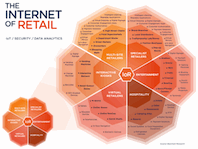Beecham Research publishes new IoT in Retail sector chart

Internet of Retail Chart, Beecham Research
Beecham Research has been working with specialist IoT event organiser Vinelake to create a new series of IoT events organised specifically around business users (see outline of events at this link). The aim of these, explains Robin Duke-Woolley, the chief executive of Beecham Research, is to be user centric and to explore the opportunities that M2M and IoT have for business users by assessing the business benefits they can gain from introducing connected device solutions.
This week saw the first of these events taking place, with the Internet of Retail event being run at a countryside venue west of London. In preparation for this, we have extended our well-known M2M Sector Map (follow this link to see our online version with hover facility) to create a sector chart for retail that we hope will be useful for retailers.
This shows the retail sector being segmented into six subsectors, as shown at the centre of the chart. Further out from these, the chart shows the typical locations for these subsectors. Further out still are the typical IoT touchpoints that may be most useful for each subsector.
Multi-site retailers
Take for example multi-site retailers. These comprise a broad range of stores offering shopping experiences, including: high street chains, food supermarkets, department stores, shopping malls and street markets. The retailers included here could also include banks, insurance companies, building societies, chemists and others as well as the usual high street chains. Shopping malls could include retail outlets at airports and travel hubs.
Multi-site retailers face the challenge of integrating different channels and stores located in different locations and geographies. This integration is necessary in order to optimize resources, but also provide a homogenous message to customers or groups of customers. Therefore the IoT strategy for multi-site retailers should emphasise this integration, making it more intelligent and seamless at the same time. The set of technologies and devices necessary for that can be quite rich and diverse.
Specialist retailers
Taking another example, specialist retailers include stores that concentrate on a particular type of merchandise rather than everyday items most people would buy from conventional high street stores. Examples include specialist sportswear such as mountaineering gear, hobby retailers, craft shops, lighting shops, needlework and wool shops, boutiques. Even small businesses of this type increasingly need to have on-line stores and a Web site to make themselves known to the public and enable remote ordering and buying.
The IoT technologies of relevance for specialists are similar to those utilised by multi-site retailers. However, the degree of complexity of specialist retailers is not the same because they are small in size and strongly specialised. However, being cutting-edge in terms of technology adoption is a key competitive advantage for those types of retailers. Therefore, in terms of IoT strategy, they want to transform their stores into smart spaces, integrating those with the on-line channels, and have a clear view on the production value-chain in order to ensure high quality products.
Developing new IoT strategies in retail
Beecham Research offers a range of support services to retailers to help explore the issues relevant for them and how they can move forward to develop their own retail IoT strategies and then implement them. For more details, e-mail businessiot@beechamresearch.com